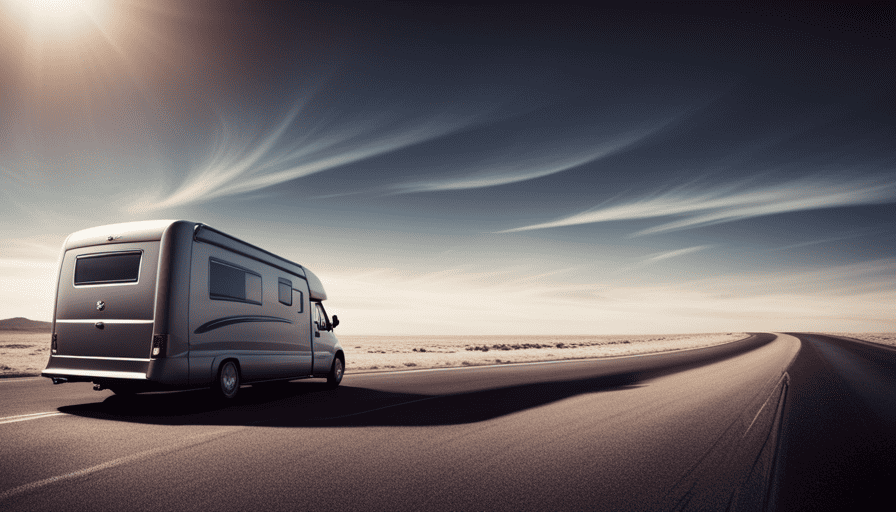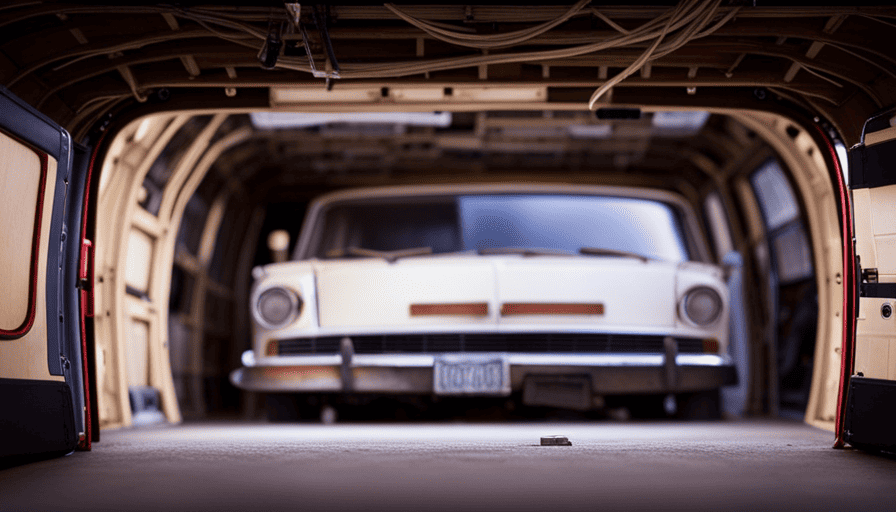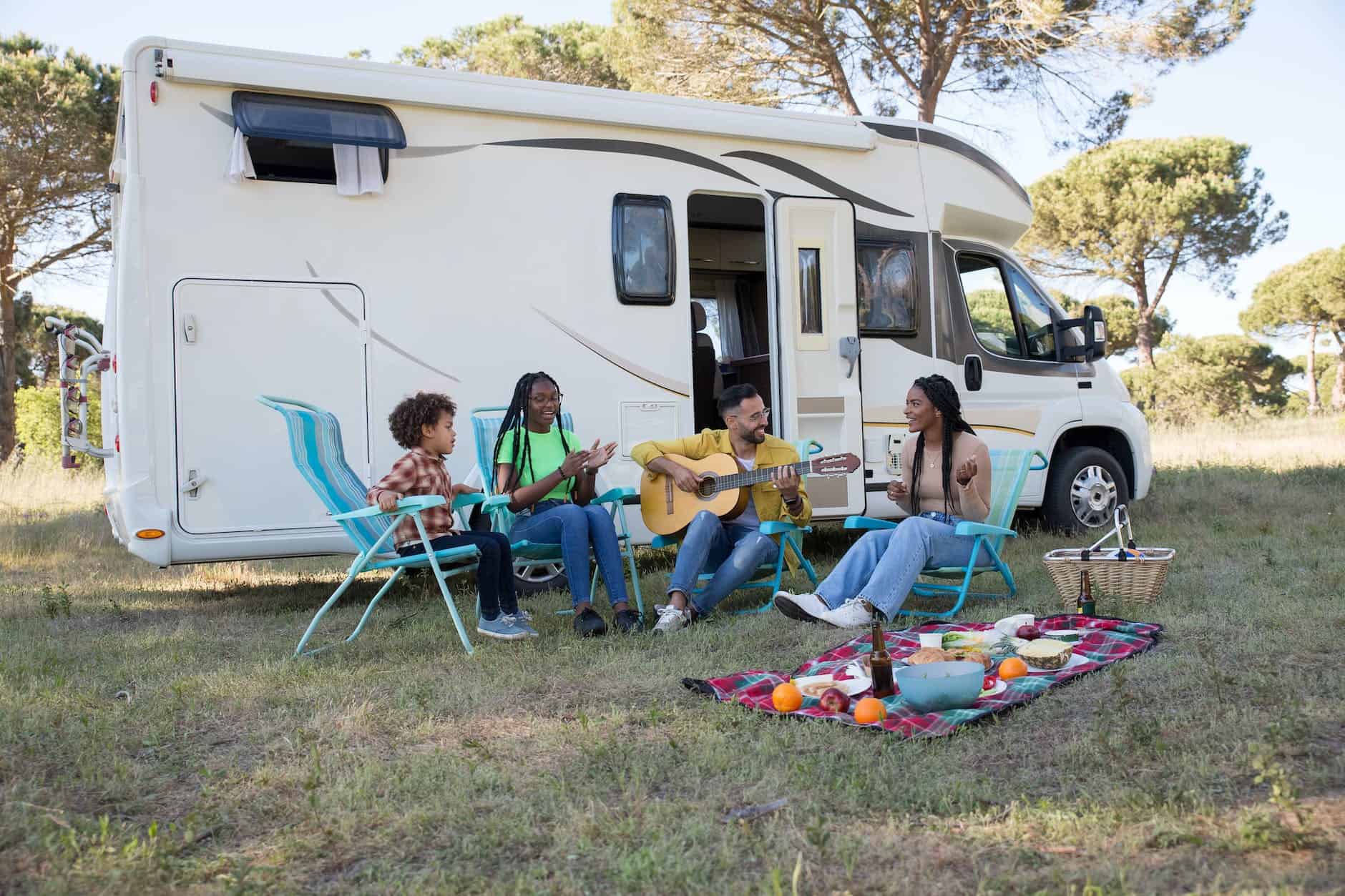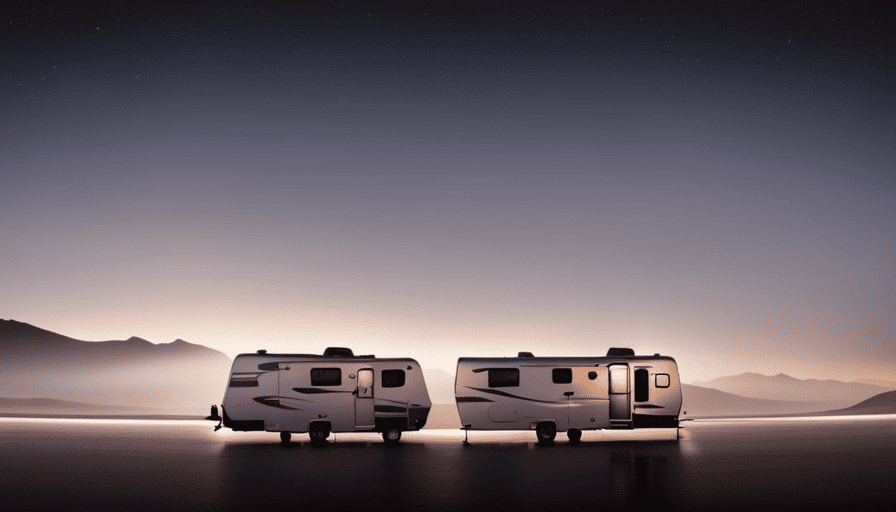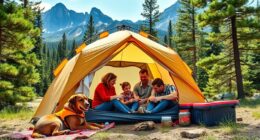Did you know that the weight of a truck camper can vary greatly depending on its size and construction materials? In fact, the weight of a truck camper can range from as low as 500 pounds to as high as 5,000 pounds!
Knowing the weight of a truck camper is not only important for ensuring safe and efficient transportation, but also for understanding its impact on your truck’s payload capacity.
In this article, we will explore the factors that contribute to the weight of a truck camper, such as its size, length, and construction materials. We will also discuss the importance of properly distributing the weight within the camper to ensure stability and safety on the road.
Whether you’re a seasoned camper or new to the world of truck campers, understanding their weight is crucial for a successful and enjoyable camping experience.
So, let’s dive in and discover how much a truck camper really weighs!
Key Takeaways
- The weight of a truck camper can range from 500 pounds to 5,000 pounds.
- Factors that affect the weight of a truck camper include materials used, size and design, amenities and features.
- Different types of truck campers have different weight ranges, with lightweight campers weighing between 1,000 to 2,000 pounds and heavy-duty campers weighing 3,000 to 5,000 pounds or more.
- Matching the weight of the truck camper with the vehicle’s towing capacity is crucial for safety and performance.
Importance of Knowing the Weight of a Truck Camper
Knowing the weight of a truck camper is crucial because it determines whether you’ll have the freedom to explore without limitations or constantly feel weighed down by restrictions. Understanding camper specifications is essential in order to make informed decisions about which model is right for you.
By knowing the weight, you can ensure that your truck can safely carry the camper without exceeding its maximum payload capacity. This knowledge will not only prevent damage to your truck, but also keep you and other drivers on the road safe.
In addition, the weight of a truck camper has a direct impact on fuel efficiency. Carrying extra weight requires more energy, which in turn increases fuel consumption. By knowing the weight of your camper, you can plan your trips accordingly and estimate how much fuel you’ll need. This will save you money in the long run and allow you to explore more places without constantly worrying about refueling.
Understanding the different components that contribute to the weight of a truck camper is the next step. By knowing how each component adds to the overall weight, you can make informed decisions about which features are essential and which you can do without.
Understanding the Different Components that Contribute to the Weight
Considering the various parts that make up a truck camper, it’s crucial to grasp the significance of each component in determining its overall weight. When checking the weight of a truck camper, it’s important to understand the weight distribution among different parts.
Here are the three main components that contribute to the weight:
-
Frame and Structure: The frame and structure of a truck camper play a major role in its weight. Typically made of steel or aluminum, the frame provides support and stability. The materials used and the design of the frame can significantly impact the overall weight of the camper.
-
Interior Furnishings and Appliances: The interior furnishings and appliances, such as cabinets, beds, kitchen appliances, and bathroom fixtures, add weight to the camper. It’s essential to consider the weight of these components as they can vary depending on the quality and size.
-
Water and Fuel Tanks: Water and fuel tanks are important components of a truck camper. These tanks can add significant weight, especially when they are full. The size and capacity of these tanks can vary, affecting the overall weight of the camper.
Understanding the different components that contribute to the weight of a truck camper is essential for proper weight distribution and safe traveling. The next section will explore the factors that affect the weight of a truck camper in more detail.
Factors that Affect the Weight of a Truck Camper
To fully understand the weight of your truck camper, let’s dive into the factors that can affect its overall heaviness.
There are several key factors that contribute to the weight of a truck camper, and each of them can have an impact on your vehicle’s performance. One of the main factors is the materials used in the construction of the camper. Different materials have different weights, so a camper made from lightweight materials will generally be lighter than one made from heavier materials.
Another factor is the size and design of the camper. Larger campers with multiple slide-outs will typically be heavier than smaller, more compact models.
Additionally, the amenities and features included in the camper can also affect its weight. Things like a larger kitchen, bathroom, or entertainment system will add to the overall weight.
It’s important to consider these factors when choosing a truck camper, as they can have an impact on your vehicle’s towing capacity and overall performance.
Speaking of size and length of the camper, let’s now explore how these factors can further affect the weight.
Size and Length of the Camper
If you’re wondering whether the size and length of your camper affects its weight, let me clarify that it does indeed impact the overall heaviness of the vehicle. The size and length of a truck camper can vary significantly, and this has a direct correlation to its weight.
Here are three ways in which camper size and length affect its weight:
-
Interior Space: Larger campers with more square footage tend to be heavier than smaller ones. This is because they require more materials for construction, such as walls, flooring, and furniture, which contribute to the overall weight.
-
Amenities and Features: Longer campers often have more amenities and features, such as additional slide-outs, which increase the weight. These extra features require additional mechanisms and materials, adding to the overall heft of the camper.
-
Payload Capacity: The size and length of a camper also impact its payload capacity. Longer campers generally have a higher payload capacity, allowing you to carry more supplies and equipment. However, this also means that the camper itself will be heavier.
Moving on to the next section about the materials used in construction, we can further explore the factors that influence the weight of a truck camper.
Materials Used in Construction
When it comes to the materials used in construction, you’ll be surprised by how significantly they can impact the weight of your camper. Manufacturers use a variety of construction materials to build truck campers, and each material has its own weight characteristics.
One common material used is aluminum, which is known for its lightweight properties. Aluminum campers are lighter compared to those made of other materials, making them easier to tow. However, they may not be as durable as campers made of other materials.
On the other hand, fiberglass campers are heavier but offer better insulation and durability.
Another factor to consider is weight distribution. The placement of heavy materials like water tanks and appliances can affect the overall weight distribution of the camper. It’s important to ensure proper weight distribution to maintain stability and prevent excessive strain on the truck.
As we move on to the next section about the features and amenities included, it’s important to consider how the weight of construction materials can impact the overall weight of the camper.
Features and Amenities Included
Outfitting your camper with luxurious amenities is like adding a touch of opulence to your home on wheels. When it comes to features and amenities, truck campers have come a long way in recent years. From spacious sleeping areas to fully-equipped kitchens, these campers offer a wide range of comforts to enhance your camping experience.
One important consideration when choosing your camper’s features and amenities is weight distribution. Adding too many heavy features to one side of the camper can lead to an imbalanced weight distribution, affecting the overall stability and safety of your vehicle. It’s crucial to carefully plan and distribute the weight of your amenities to ensure a smooth and safe ride.
Some popular features and amenities found in truck campers include air conditioning, heating systems, hot water heaters, showers, toilets, refrigerators, and stoves. Additionally, many campers offer slide-out rooms, which can expand the living space inside the camper when parked. These features not only add convenience but also contribute to the overall weight of the camper.
Considering the features and amenities you desire in your camper is important, but it’s equally important to be mindful of their weight distribution. By carefully planning and organizing these amenities, you can ensure a comfortable and safe camping experience.
Moving forward, let’s explore the average weight range for different types of truck campers.
Average Weight Range for Different Types of Truck Campers
Truck campers of various types typically have an average weight range that can significantly impact the overall stability and safety of your vehicle. These campers come in different weight classifications, ranging from lightweight to heavy-duty models. The weight of a truck camper depends on various factors such as size, construction materials, and the amenities included.
Lightweight truck campers, also known as pop-up campers, are the lightest in weight. They usually weigh between 1,000 to 2,000 pounds. Being lightweight, they have minimal impact on fuel efficiency and are easier to maneuver on the road. However, they may not offer as many features and amenities as their heavier counterparts.
On the other end of the spectrum, heavy-duty truck campers can weigh anywhere from 3,000 to 5,000 pounds or even more. These campers are designed for maximum durability and often come with a wide range of amenities, including full-size kitchens, bathrooms, and ample living space. However, their weight can significantly impact the fuel efficiency of your truck.
Transitioning into the subsequent section about pop-up truck campers, these lightweight campers offer a great solution for those looking for a compact and fuel-efficient option without compromising on comfort and convenience.
Pop-Up Truck Campers
Imagine yourself cruising down the open road, effortlessly towing a compact and fuel-efficient pop-up truck camper that provides comfort and convenience without sacrificing space. Pop-up truck campers are a popular choice among outdoor enthusiasts due to their lightweight design and versatility. They are typically made of lightweight materials such as aluminum or fiberglass, which significantly reduces their weight compared to other types of truck campers. This makes them easier to tow and allows for better fuel efficiency.
One of the major advantages of pop-up truck campers is their ability to expand, providing ample living space when parked. When folded down, they have a low profile, which not only reduces wind resistance but also allows for better maneuverability. Additionally, their compact size makes them ideal for off-road adventures or exploring narrow and winding roads.
However, there are a few drawbacks to consider. Pop-up truck campers may not be as durable as their hard-side counterparts, making them more susceptible to wear and tear. Their canvas or tent-like walls may require regular maintenance and waterproofing to prevent leaks and damage. It’s also important to note that these campers may not provide the same level of insulation as hard-side truck campers, which can be a concern in extreme weather conditions.
Pop-up truck campers offer a lightweight and versatile option for those looking for a comfortable camping experience on the road. While they have their pros and cons, regular maintenance and proper care can help maximize their lifespan and ensure enjoyable adventures.
Transitioning to the subsequent section about hard-side truck campers, these campers offer a more solid and durable option for camping enthusiasts.
Hard-Side Truck Campers
One of the things that people love about hard-side truck campers is their durability and sturdiness, making them a reliable choice for camping enthusiasts. These campers are built to withstand rough terrain and harsh weather conditions, ensuring that you can enjoy your camping adventures without worrying about your shelter.
When it comes to choosing a hard-side truck camper, it’s important to consider the matching truck size and camper compatibility. Here are four reasons why hard-side truck campers are a popular choice:
-
Enhanced insulation: Hard-side truck campers provide superior insulation, keeping you warm in cold weather and cool in hot weather. This ensures a comfortable camping experience regardless of the outside temperature.
-
Ample storage space: These campers are designed with plenty of storage compartments, allowing you to bring all your camping essentials without feeling cramped. From kitchen utensils to outdoor gear, you can easily store everything you need for your trip.
-
Increased security: Hard-side truck campers offer enhanced security features, including sturdy locks and reinforced doors. This provides peace of mind knowing that your belongings are safe and secure while you’re out exploring.
-
Better noise reduction: Compared to pop-up truck campers, hard-side truck campers offer better noise reduction. This means you can enjoy a peaceful night’s sleep without being disturbed by outside noises.
With these benefits in mind, it’s easy to see why hard-side truck campers are a popular choice among camping enthusiasts.
Now, let’s delve into the world of slide-in truck campers.
Slide-In Truck Campers
Get ready to slide into the world of slide-in truck campers and experience the cozy embrace of a portable home on wheels.
Slide-in truck campers are a popular choice for those looking for a versatile and convenient camping solution. These campers are designed to slide into the bed of a pickup truck, allowing for easy transportation and setup.
One of the key considerations when it comes to slide-in truck campers is weight distribution. Since these campers sit in the bed of a truck, it’s important to ensure that the weight is evenly distributed to maintain stability and safe driving conditions. Manufacturers provide weight ratings for their campers, including the dry weight and the weight when fully loaded.
It’s crucial to determine the weight of a specific truck camper before hitting the road to ensure that your truck can safely handle the load.
In the next section, we’ll explore how to determine the weight of a specific truck camper without compromising safety or performance.
How to Determine the Weight of a Specific Truck Camper
When it comes to slide-in truck campers, one of the most important things to consider is their weight. Knowing how much a truck camper weighs is crucial for a couple of reasons. First, it helps determine whether your truck can safely handle the weight of the camper. Second, it affects the overall performance and fuel efficiency of your vehicle.
To determine the weight of a specific truck camper, there are a few steps you can take. First, you can start by looking for a weight sticker on the camper itself. This sticker is usually located on the exterior or inside one of the cabinets. It provides information about the camper’s weight, including the dry weight and the weight when fully loaded.
If you can’t find a weight sticker, you can use a truck scale to weigh your vehicle with and without the camper attached. This will give you a more accurate measurement of the camper’s weight and allow you to calculate the weight distribution between the truck and the camper.
Determining the accuracy of the weight is essential for safe towing and handling. Once you have determined the weight of the camper, you can then check the manufacturer’s specifications to ensure that your truck is capable of safely carrying it.
Checking the Manufacturer’s Specifications
Checking the manufacturer’s specifications is crucial for ensuring the safe and efficient handling of your vehicle and camper. When determining the weight of a specific truck camper, it’s important to refer to the manufacturer’s specifications to obtain accurate information. These specifications can usually be found in the owner’s manual or on the manufacturer’s website.
By checking these specifications, you can ensure that you have the most up-to-date and accurate information about the weight of your truck camper. Comparing the manufacturer’s specifications with the actual weight of your truck camper is essential for accuracy. Sometimes, the actual weight may differ from what’s listed in the specifications due to factors such as added accessories or modifications. It’s important to take these differences into account when determining the weight of your truck camper.
Once you have checked the manufacturer’s specifications and compared them with the actual weight, you can proceed to the next step of using a weigh station to confirm the weight of your truck camper. This will provide you with the most accurate and reliable measurement, ensuring that you have the correct information for safe and efficient handling of your vehicle and camper.
Using a Weigh Station
Once you’ve confirmed the weight of your truck camper, it’s time to hit the road and head to a weigh station to get the true measure of your rig’s heft. Weigh stations are facilities specifically designed for weighing vehicles and ensuring they comply with weight regulations. They are usually located along highways and are easily accessible for truck campers and other large vehicles.
When you arrive at a weigh station, you’ll need to follow the instructions provided by the facility. Typically, you’ll be directed to park your truck camper on a designated scale. The weighing process is straightforward and usually involves three simple steps:
-
Pull onto the scale: Drive your truck camper onto the scale platform until it is fully positioned.
-
Get weighed: Once your rig is in place, the scale operator will initiate the weighing process. The scale will measure your truck camper’s weight accurately.
-
Receive the weight ticket: After the weighing process is complete, the scale operator will provide you with a weight ticket. This ticket will display your truck camper’s weight and other relevant information.
Using a weigh station is essential to determine the exact weight of your truck camper. Overloading your rig can have serious implications, including reduced maneuverability, increased stopping distance, and potential damage to your vehicle and its components. Therefore, knowing your truck camper’s weight is crucial for safe and responsible travel.
Transition: Understanding the weighing process is just the first step. Now, let’s explore the implications of overloading a truck camper.
Implications of Overloading a Truck Camper
Understanding the consequences of overloading a truck camper can help ensure safe and responsible travel. When a truck camper is overloaded, it can have serious implications on both safety and performance.
One of the main safety risks on the road is the increased likelihood of accidents. Overloading a truck camper can negatively impact the vehicle’s handling and braking capabilities, making it more difficult to control. This can lead to accidents, especially in emergency situations where quick maneuvering is required.
Additionally, overloading a truck camper can put excessive strain on the vehicle’s tires, suspension, and brakes. This can lead to premature wear and tear, reducing the overall lifespan of these components. It can also cause the vehicle to become unstable, making it more prone to rollovers or tire blowouts.
Not only does overloading pose safety risks on the road, but it can also have an impact on vehicle performance. An overloaded truck camper may experience decreased fuel efficiency, as the engine has to work harder to pull the extra weight. It can also lead to decreased acceleration and overall performance, making it more difficult to navigate steep inclines or travel at higher speeds.
Understanding the implications of overloading a truck camper is crucial for safe and enjoyable travel. By avoiding overloading, we can ensure a smoother and safer journey.
Transitioning into the next section, it’s also important to consider the impact on vehicle performance.
Impact on Vehicle Performance
Moving on from the implications of overloading a truck camper, let’s delve into the impact it can have on vehicle performance. When a truck camper exceeds its weight capacity, it can adversely affect several aspects of the vehicle’s performance, including fuel efficiency, handling, and stability.
Firstly, let’s consider the impact on fuel efficiency. An overloaded truck camper requires the engine to work harder, resulting in increased fuel consumption. This can be a significant factor, especially during long journeys or when traveling through hilly terrains. The additional weight puts a strain on the engine, causing it to burn more fuel to maintain the desired speed.
Moreover, overloading a truck camper can have detrimental effects on handling and stability. The added weight shifts the center of gravity, making the vehicle more prone to swaying and instability. This can make it challenging to maneuver the vehicle safely, particularly during turns or sudden lane changes. Furthermore, braking distances may increase, compromising the vehicle’s ability to stop quickly in emergency situations.
To provide a comprehensive understanding of the impact on vehicle performance, let’s take a look at the following table:
| Aspect | Impact of Overloading |
|---|---|
| Fuel Efficiency | Decreased mileage, increased fuel consumption |
| Handling | Reduced maneuverability, increased swaying |
| Stability | Compromised balance, potential for accidents |
Considering these factors, it becomes evident that overloading a truck camper can have significant repercussions on vehicle performance, compromising fuel efficiency, handling, and stability. These effects not only impact the driver’s experience but also pose safety risks on the road.
Safety Risks on the Road
Given the potential for disaster, it’s a wonder anyone would dare to overload their truck camper and risk turning their vehicle into a wobbly, fuel-guzzling accident waiting to happen. When it comes to safety risks on the road, the weight of a truck camper plays a significant role.
Exceeding the recommended weight limits can lead to a variety of road hazards, including compromised handling, increased braking distance, and decreased stability. One of the primary safety risks associated with an overweight truck camper is compromised handling. The added weight can make the vehicle more difficult to control, especially in emergency situations or when maneuvering at high speeds. Additionally, an overloaded truck camper can increase the braking distance, making it harder to stop quickly when necessary.
To mitigate these risks, it is essential to follow maintenance precautions. Regularly inspecting and maintaining your vehicle’s brakes, tires, suspension, and chassis becomes even more critical when carrying a heavy load. Adequate tire pressure, proper alignment, and regularly checking for signs of wear and tear are essential for safe travels.
In the next section about matching the weight of the truck camper with your vehicle’s towing capacity, it is crucial to consider these safety risks and take necessary precautions. By ensuring that the weight of your truck camper falls within the recommended limits, you can avoid potential road hazards and travel with peace of mind.
Matching the Weight of the Truck Camper with Your Vehicle’s Towing Capacity
To ensure a safe and smooth journey, it’s crucial for you to match the weight of your truck camper with your vehicle’s towing capacity. Matching towing capacity is important because if the weight of the truck camper exceeds what your vehicle can handle, it can lead to various safety risks on the road.
Here are some key points to consider when matching towing capacity and weight distribution:
-
Know your vehicle’s towing capacity: Check your vehicle’s owner’s manual or consult with the manufacturer to determine the maximum weight it can safely tow.
-
Weigh your truck camper: Use a scale to accurately measure the weight of your truck camper, including any additional gear or supplies.
-
Consider weight distribution: Ensure that the weight of the truck camper is evenly distributed to maintain proper balance and stability while towing.
-
Factor in additional cargo: Remember to account for any additional cargo you may be carrying in your truck or camper, as this will add to the overall weight.
-
Consult with experts: If you’re unsure about matching towing capacity or weight distribution, seek advice from professionals who specialize in truck campers and towing.
Matching the weight of your truck camper with your vehicle’s towing capacity is essential for a safe and enjoyable journey.
Now let’s move on to some tips for choosing a lightweight truck camper.
Tips for Choosing a Lightweight Truck Camper
Picking a lightweight truck camper can be like finding a feather in a haystack. When it comes to choosing a camper that won’t weigh you down, there are a few key factors to consider.
One of the most important aspects is the camper’s construction. Look for campers that are made with lightweight materials such as aluminum or fiberglass. These materials not only reduce the overall weight of the camper but also contribute to better fuel efficiency. By opting for a camper with lightweight construction, you can save money on fuel costs and enjoy a smoother ride.
In addition to lightweight construction, another tip for choosing a lightweight truck camper is to opt for compact designs. Compact campers are not only easier to tow but also offer better maneuverability on the road. They are perfect for those who prefer to travel to remote locations or navigate narrow roads. With a compact camper, you can easily park in tight spaces and explore off-the-beaten-path destinations.
When searching for a lightweight truck camper, prioritize features like lightweight construction and compact designs. These factors not only contribute to better fuel efficiency but also make your camping experience more enjoyable. Now let’s move on to the next section and explore the benefits of opting for a compact design.
Opt for Compact Designs
Choosing a compact design for your lightweight truck camper opens up a world of possibilities for adventurous explorations and hassle-free parking. Compact designs are specifically engineered to maximize space and minimize weight, making them an excellent choice for those seeking portability and maneuverability.
Here are three reasons why opting for compact designs can greatly enhance your camping experience:
-
Easy Maneuverability: Compact truck campers are designed to fit in tight spaces, allowing you to easily navigate through narrow roads and tight camping spots. This makes it easier to reach remote and off-the-beaten-path destinations, expanding your options for exploration.
-
Fuel Efficiency: With a smaller and lighter design, compact truck campers require less fuel to transport. This not only saves you money at the pump but also reduces your carbon footprint, making it a more eco-friendly choice.
-
Versatility: Despite their smaller size, compact truck campers still offer a range of features and amenities. From built-in kitchens and bathrooms to comfortable sleeping quarters, these campers provide all the essentials for a comfortable camping experience.
By choosing a compact design, you can enjoy the benefits of lightweight options while still having all the comforts of home. Consider alternative materials for your truck camper to further optimize weight and durability.
Consider Alternative Materials
Have you ever wondered how using alternative materials can enhance the durability and weight of your lightweight truck camper? When it comes to truck campers, the weight is a crucial factor to consider, as it directly impacts fuel efficiency and overall performance. Opting for alternative materials can significantly reduce the weight of your camper without compromising its strength and durability.
There are several weight-saving options available in the market that can help you achieve a lighter camper. One popular alternative material is fiberglass. Fiberglass is known for its lightweight properties while still being sturdy and weather-resistant. It’s a great option for those who want to reduce the weight of their camper without sacrificing durability.
Another option is aluminum. Aluminum is a lightweight material that’s also highly resistant to rust and corrosion. It’s commonly used in the construction of truck campers due to its strength and durability.
In addition to fiberglass and aluminum, there are also composite materials available that offer a combination of lightweight and durability. These materials are made by combining different materials to create a stronger and lighter structure.
Considering alternative materials is an excellent way to reduce the weight of your truck camper while maintaining durability. By choosing lightweight materials like fiberglass, aluminum, or composite materials, you can enhance the performance of your camper without sacrificing its strength. Prioritizing essential features, such as alternative materials, is crucial in designing a lightweight truck camper that suits your needs.
Prioritize Essential Features
One essential feature to prioritize in a lightweight truck camper is its durability. When choosing a lightweight truck camper, it’s important to consider the materials used in its construction. Opting for alternative materials, such as fiberglass or aluminum, can significantly reduce the weight of the camper without compromising its strength and durability.
Additionally, it’s crucial to prioritize essential features that are necessary for your specific needs. This includes considering the size of the camper, the number of beds, kitchen amenities, and bathroom facilities. By prioritizing these features, you can ensure that you have everything you need while still keeping the weight of the camper to a minimum.
Choosing lightweight options is not only important for fuel efficiency and ease of towing, but also for the overall stability of the camper. Properly distributing the weight in a truck camper is crucial to ensure safe and smooth travels.
In the subsequent section, we’ll discuss the importance of properly distributing the weight in a truck camper without compromising its stability and handling.
Importance of Properly Distributing the Weight in a Truck Camper
To ensure a smooth and stable ride, it’s crucial that you properly distribute the weight in your lightweight truck camper, creating a balanced and secure traveling experience. Proper weight distribution plays a significant role in the overall stability of your vehicle. When the weight is not evenly distributed, it can lead to a range of issues, including reduced control, increased sway, and potential damage to your camper and truck.
Proper weight distribution has a direct impact on vehicle stability. When the weight is concentrated in one area, it can create an imbalance, causing the vehicle to become unstable. This can result in difficulty steering, increased braking distance, and a higher risk of accidents.
By distributing the weight evenly throughout the camper, you can minimize these risks and ensure a safer journey.
Balancing the load is essential to achieve proper weight distribution. It involves placing heavier items closer to the center of the camper and distributing lighter items towards the outer edges. This helps maintain the camper’s center of gravity and prevents it from swaying excessively while on the road.
By understanding the importance of proper weight distribution and taking the necessary steps to balance the load, you can enjoy a more stable and secure traveling experience.
So let’s dive into the next section and explore how to effectively balance the load in your truck camper.
Balancing the Load
Achieving a balanced load in your truck camper is crucial for a stable and secure journey on the road. Balancing weight distribution is essential to ensure that the weight is evenly distributed throughout the camper, preventing any potential issues such as swaying or tipping.
When loading your truck camper, it’s important to distribute the weight evenly from side to side and front to back. This can be achieved by placing heavier items in the center of the camper, closer to the axle. By doing so, you can maintain a proper balance and prevent any potential weight imbalances that could affect the stability of your camper during travel.
In addition to balancing the weight distribution, securing cargo is equally important. It’s essential to secure all items properly to prevent them from shifting or falling during transit. Use straps, bungee cords, or cargo nets to secure larger items, and make sure to double-check that everything is tightly secured before hitting the road.
By balancing the load and securing your cargo, you can ensure a safe and smooth journey in your truck camper.
Now, let’s move on to the next section where we’ll discuss the importance of securing items for safe transport without compromising the weight distribution.
Securing Items for Safe Transport
Securing items properly is absolutely crucial for a smooth and worry-free journey in your trusty truck camper. When it comes to securing items, it’s not just about preventing them from moving around during transit, but also about ensuring proper distribution of weight to maintain stability on the road.
The last thing you want is for your truck camper to become unbalanced and potentially tip over.
To secure items for safe transport, start by using bungee cords, straps, or cargo nets to secure larger items. These can be attached to the interior walls or the tie-down points in your truck camper. Make sure to tighten them enough to prevent any shifting or sliding.
For smaller items, consider using storage bins or organizers that can be securely fastened to prevent them from falling or rolling around.
Proper distribution of weight is also important. Place heavier items lower and towards the center of your truck camper to maintain balance. Distribute the weight evenly from side to side as well, to avoid an imbalance that could affect the stability of your vehicle.
Securing items properly and ensuring proper weight distribution is essential for a safe and enjoyable journey in your truck camper. By taking the time to secure your belongings and distribute weight appropriately, you can have peace of mind knowing that everything is in its place and your truck camper is ready for the road ahead.
Conclusion and Final Thoughts on the Weight of Truck Campers
In conclusion, it’s imperative to carefully consider the weight distribution and securing of items within a truck camper to ensure a safe and stable journey. Overweight truck campers can have serious implications on both safety and fuel efficiency.
When a truck camper is overloaded, it can put excessive strain on the tires, suspension, and braking system, leading to increased wear and tear and potential mechanical issues. This not only compromises the safety of the vehicle but also poses a risk to other road users.
Additionally, an overweight truck camper can negatively impact fuel efficiency. The engine has to work harder to move the extra weight, resulting in increased fuel consumption. This not only puts a dent in your wallet but also contributes to environmental pollution.
To maintain optimal fuel efficiency, it’s crucial to keep the truck camper within its recommended weight limits and properly secure all items inside. This can be achieved by distributing the weight evenly and using appropriate tie-downs and fasteners.
By doing so, you can enjoy a safe and economical journey with your truck camper.
Frequently Asked Questions
Can I tow a truck camper if my vehicle’s towing capacity is lower than the camper’s weight?
If your vehicle’s towing capacity is lower than the weight of a truck camper, alternative towing options are available. One interesting statistic to consider is that there are over 40 million registered recreational vehicles in the US, highlighting the popularity of camping and road trips. To calculate the weight of a truck camper, you need to know the dry weight, which excludes any additional cargo or water. This information helps determine if your vehicle can safely tow the camper.
What are the potential risks and dangers of overloading a truck camper?
Overloading a truck camper can have serious risks and consequences. When a camper is overweight, it can strain the vehicle’s suspension, brakes, and tires, leading to decreased stability and increased stopping distances. This can result in accidents and loss of control on the road.
Additionally, an overloaded camper can cause damage to the vehicle’s frame and chassis, leading to expensive repairs. It’s crucial to always stay within the recommended weight limits to ensure safe and worry-free travels.
How does the weight of a truck camper affect the performance and handling of the towing vehicle?
How does the weight of a truck camper affect the performance and handling of the towing vehicle?
Have you ever wondered how to calculate the weight distribution in a truck camper?
When towing a truck camper, there are several factors to consider. The weight of the camper can greatly impact the performance and handling of the towing vehicle. It can affect acceleration, braking, and overall stability.
Proper weight distribution and ensuring that the towing vehicle is equipped to handle the camper’s weight are crucial for safe and efficient towing.
Are there any tips for choosing a lightweight truck camper?
When it comes to choosing a lightweight truck camper, there are a few tips to keep in mind. First, consider the materials used in its construction, such as aluminum or fiberglass, as these are lighter than traditional materials.
Additionally, look for compact designs that minimize weight without sacrificing functionality. The advantages of lightweight truck campers include improved fuel efficiency, easier maneuverability, and reduced strain on the towing vehicle.
Choosing a lightweight option can greatly enhance your camping experience.
Why is it important to properly distribute the weight inside a truck camper and how can this be achieved?
Proper weight distribution in a truck camper is crucial for achieving balance and avoiding potential dangers. Improper weight distribution can lead to instability, decreased fuel efficiency, and even accidents.
To achieve proper weight distribution, start by placing heavier items low and centered. Keep in mind the camper’s weight limit and distribute the load evenly on all sides. When choosing a lightweight truck camper, consider its weight capacity, design, and materials to ensure easier weight distribution.
Is the Weight of a Truck Bed Camper Different from a Truck Camper?
The weight of a truck bed camper and a truck camper can differ. The term truck bed camper weight refers specifically to the weight of the compact sleeping unit that is placed directly on the bed of a pickup truck. On the other hand, a truck camper includes additional living space that extends over the cab of the truck, making it usually heavier than a truck bed camper.
Conclusion
In conclusion, knowing the weight of a truck camper is absolutely crucial! It’s not just a mundane number; it’s the difference between a smooth ride and a disastrous disaster waiting to happen.
With the right knowledge, you can ensure your camper is properly balanced and secure, preventing any unwanted surprises on the road. So don’t take this lightly! Make sure you know the weight of your truck camper and take the necessary steps to keep yourself and your belongings safe.
Remember, a little bit of knowledge can go a long way!

